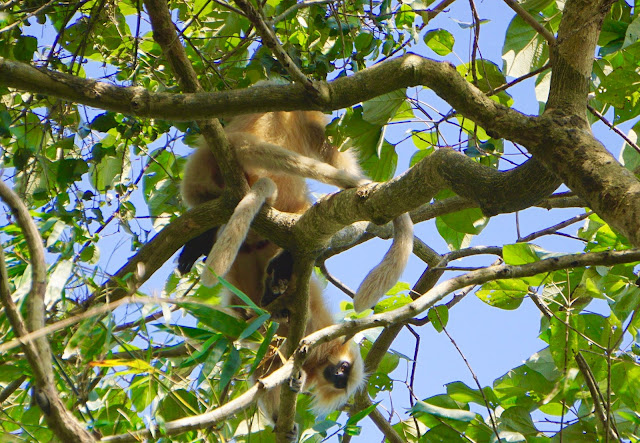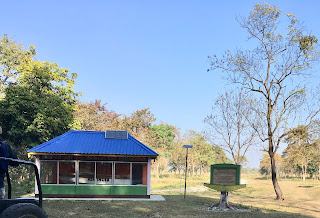40 degree days are upon us in Chennai, and the midday air is like a furnace. Whatever I touch is hot, the bed, clothes, drinking water. Every year I go through this, and every year it's like I don't remember it!
The COVID positives are continuing to rise, in Chennai, in TN and in large parts of India, and daily wage earners are continuing to move in their hundreds back to the Hindi heartland and the north east. In the middle of this cyclone Amphan has struck as well.
13th January 2020
Continued from here
The COVID positives are continuing to rise, in Chennai, in TN and in large parts of India, and daily wage earners are continuing to move in their hundreds back to the Hindi heartland and the north east. In the middle of this cyclone Amphan has struck as well.
13th January 2020
Continued from here
We were given a choice for today - to go look for the Bengal Florican at the Kolkilabarii grasslands, or go in search of the Golden Langurs at the Kakoijana Reserve Forest. Everyone wanted to see the langurs, and so we chose the Kakoijana RF and the golden langurs over the florican. What a day it turned out to be and what an exhilarating, sad and humbling experience.
 |
| Driving past characteristic Asamese home with little ponds, bamboo fences, |
 |
| and electric autos everywhere. |
 |
| Crossing the river (Manas? or was it Aiee?), the mist over the water, so beautiful and peaceful was the scenery outside. |
 |
| Sanjeev took us into his house. We saw his mother and children, getting ready for Bihu, pounding rice. Another young man was working on bamboo - and more about that later |
And then we set off to climb the hill ahead. We crossed the fallow fields, using makeshift bamboo poles as bridges across water nullahs, cows mooed and looked inquisitively at us. Quite different from the indifferent and emotionless cows of Madras I thought.
We meandered along in true MNS style, examining every ber tree and bamboo tree, looking at every drongo and butterfly - the only ones moving with urgency were Pranjal and Yuvan. Pranjal and Yuvan, two young men from different parts of the country, united in their love and passion for the environment and the natural world. By day two itself there was such a bond between them, they were inseparable - they travelled in the same jeep, and drove each other to more discoveries, exchange of information, and on the road trips, even music lists were shared.
We reached the hills and began our ascent, Sanjeev quickly assessed that at the pace we were making we would take all day to reach the top of the hill - and the more we delayed the further upwards the langurs would go, he said. A few phone calls were made, and much Assamese exchanged, and then he announced that a troop of langurs had come into the bamboo groves at the foothills on the other side, so we should hurry around to that village! So the message was relayed up and down the group, and we made haste (well not really) back to the vehicles!
We reached another beautiful little Asaamese house, and we walked silently though their prayer space, backyard and into a bamboo grove.
Sonali bandar
Sanjeev signalled us to tread softly and keep our voices down. I craned my neck to look up but really could not see them! Excited voices, much finger pointing, come here, look there - and then I did see them. A smallish troop/family, resting up in the canopy - and resting seems to include some random sex on the part of the male, with the female not even paying notice it seemed!
 |
| A wonderful shot by Elumalai, of this magnificent primate - feeds on many different kinds of vegetation, though bamboo is a favourite I think. |
There are 34 villages around Kakojiana, and they have somehow banded together to help these beautiful primates. Sanjeev was from the Rajabonshis village, and we had moved to the Garo village. We were told there were Bodo, Santhal, Bengali, Nepali and Rapha villages also around the hills of Kakojiana.
On returning to Chennai, I looked up the area in Google Maps, and you see this little bunch of hills, surrounded by these villages. And one side now, mining seems to have started now - a very bad idea indeed. Janaki Lenin writes about the conservation effort at Kakojiana.
 |
| Find the Rat Snake in the picture - looks like it had just fed, or was snoozing as it moved not an inch! |
After seeing an Asamese rat snake up on the tree, we wandered back through the Garo house into the vehicles and drove back to Sanjeev’s house and that village.
 |
| The courtyard |
 |
| The cat also used the "bridge" across the water channel. |
 |
| Bamboos being readied for fence poles which i converted into a vase! |
One was hard like a nut, but as soon as you put it in your mouth, it would begin dissolving! Needless to say, I had several!
 |
| There would be a Bihu bonfire in the night a few days later, and this was being readied - an aeroplane of straw, for a good bang and drama. |
 |
| I watched the injured rhino for a while, happy to wander on my own. Others were also spread across the road, watching different things. |
 |
| This photo by Sudar shows the myna, picking the maggots from the wound, in a sense keeping the wound clean, but at the same time maybe not allowing the wound to heal by the constant pecking? |
 |
| Seeing the rear was a ghastly site, as this where the full extent of its injuries were seen. A large gaping wound. I wondered if it would survive this wounding. |
"This NGO was started by a group of local youth with the aim of preserving the Manas sanctuary. They recounted how they convinced the local people about preserving the pristine nature of the sanctuary. They encouraged responsible tourism. They encouraged the local people to develop other indigenous skills like weaving and pig rearing to reduce their dependence on the forest. They have succeeded in getting some Bodo villages to continue with their traditional occupation of pig rearing. The Bodo people have found it to be viable alternative and their dependence on the forest has reduced drastically. They also helped Manas sanctuary to become poaching free. The rhino at Manas were relcoated from Kaziranga and is one of the rhino conservation success stories. In the process the other animals like bison, water buffalo, elephants, wild boar, birds, insects, the trees and the grass have also got protection. As people learned the value of keeping the sanctuary in its unspoilt state Manas was able to retain its status as a UNESCO world heritage site. The MEWS members were all self taught and had learned to identify birds from books given to them by guests. It was clear that they were very proud of their sanctuary."
 |
| The MEWS office bearers speaking with us. Florican is run by them, and was even initially built by them |
It was an interesting and heartening interaction, and I learnt so much about inclusion of local people in conservation solutions - after all, the bio-fencing with lime and the raising of pigs were a very local solution. Boundaries near the settlements were being solar fenced as well.
I wished they would involve the women in the forefront too and in their committees, after all women like Malathi seemed more than capable of being part of the solution.
The MEWS were a mixed bunch - adivasis, Garos and Bodos as well. Outsiders cannot hold property in this area run by the Bodos. As I listened to how loopholes in the rule of only locals being allowed to own land in the area were being found, I hoped that egos and self interest would not drive this group apart. Already big investments in hospitality were coming into the area via the locals.
And so we went to bed that night, doing some packing as we were leaving the next morning. Stuffing all the several layers of warm clothe could only happen in the morning.
January 14th - goodbye Manas
It was to be a departure after breakfast, so I woke up early walk down to the river and have my final views of the Beki river and the Bhutan hills. It was a lovely morning.
 |
| Good bye rhino, I hope you recovered. |
In the distance to my left (downstream) was a sandbank in the middle of the river filled with tents and pandals - the site of the Bihu festivities around here - but really in the middle of the river?
 |
| I hope Sekar and I can come back here again, and the place is as beautiful as ever. |
 |
| What would I do different? I would explore using this as an entry to Bhutan and the Royal Manas Park as well. |
On to Orang!




























































